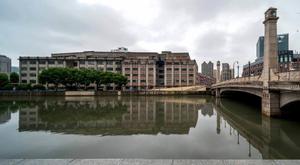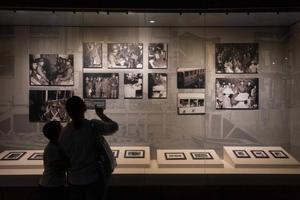 Visitors photograph the Sihang Warehouse Memorial Hall. The holes in the western wall from bombs and bullets serve as a reminder of the battle that took place at the site. (ZHANG HENGWEI / CHINA NEWS SERVICE)
Visitors photograph the Sihang Warehouse Memorial Hall. The holes in the western wall from bombs and bullets serve as a reminder of the battle that took place at the site. (ZHANG HENGWEI / CHINA NEWS SERVICE)
Zhang Haojie and his girlfriend visited a landmark site in downtown Shanghai on Aug 25.
The film, The Eight Hundred, is based on events that took place at the Sihang Warehouse during the war against the Japanese
Standing by the gate to the Sihang Warehouse Memorial Hall, the site of a critical battle in the War of Resistance Against Japanese Aggression (1931-45), Zhang told his partner, "I guess I would have acted the same as the troops back then if I'd been in their situation. After all, it is a matter of life and death in battle, and you don't have a choice."
The paint on the museum's western wall has been removed, exposing red bricks beneath. Holes in the upper section of the wall, both large and small, are evidence of the fierce gunfire from Japanese troops as they attacked.
Like many other visitors to the museum, located on the north bank of Suzhou Creek, Zhang was drawn to the site by the war movie The Eight Hundred, which he had just watched.
 A poster for The Eight Hundred. (HUANG JINKUN / FOR CHINA DAILY)
A poster for The Eight Hundred. (HUANG JINKUN / FOR CHINA DAILY)
Ma Youjiong, head of the memorial hall, said the film has attracted large numbers of new visitors to the museum. "We used to have no more than 500 visitors a day, but now we are receiving about five times that number," Ma said.
"To contain the COVID-19 pandemic, we introduced an online reservation system, and are limiting the number of visitors to 2,500 a day."
ALSO READ: TV series to tell story of Korean War to mark key anniversary
Visitors to the hall have to make reservations a few days in advance.
Zhang and his girlfriend visited the site during the Qixi Festival, or Chinese Valentine's Day.
"I have always been aware of the Sihang site. I know it marks an important time in Shanghai's history, but without seeing it in person, it was impossible to imagine the brutality of the war. The movie made a deep impression on me," Zhang said.
The Eight Hundred, which premiered in cinemas across China on Aug 21, is by far the country's biggest box-office success of the year.
Directed by Guan Hu and produced by Huayi Brothers Media Corp in association with nearly 20 other companies, the movie earned 1.5 billion yuan (US$218 million) in the first week of its release, a large proportion of the nationwide box office total of 5 billion yuan this year to date.
The film is based on events that took place at the Sihang Warehouse during the war against the Japanese.
 The battle at Sihang Warehouse during the War of Resistance Against Japanese Aggression (1931-45). (HAN FU / FOR CHINA DAILY)
The battle at Sihang Warehouse during the War of Resistance Against Japanese Aggression (1931-45). (HAN FU / FOR CHINA DAILY)
Soldier's death leap
One scene in particular, based on a real incident, that struck Zhang and many other moviegoers features soldier Chen Shusheng, with hand grenades tied to his body, jumping to his death from a wall, killing Japanese troops hiding underneath.
A note left by Chen to his mother stated that he wanted to sacrifice his life for a just cause.
Chen was one of some 400 soldiers and their officers from the First Battalion of the 524th regiment of the 88th division of the Chinese Army defending the Sihang Warehouse under the leadership of Xie Jinyuan.
The battle took place in 1937, when the main force of the army, after losing to the Japanese in Zhabei, Shanghai, withdrew to the rural western fringes of the city. Xie and the battalion were left behind, guarding the divisional headquarters at the Sihang Warehouse to buy time and show the international community that China was determined to resist the Japanese.
Xie and his troops fought valiantly from Oct 26 to Nov 1, and the successful defense of the warehouse was witnessed by locals and expatriates in the international settlement on the other side of Suzhou Creek.
The soldiers and their officers later became known as The Eight Hundred Warriors, as Xie in an attempt to hide their true strength from the enemy, provided an exaggerated figure to Yang Huimin, a visiting girl scout, who announced it publicly.
Handwritten testimony is on view at the memorial hall, signed by local resident Shen Ji on July 1, 2015, when Shen was 92. It states: "I was a 14-year-old middle school student in 1937. My family lived on Xinzha Road. The Sihang Warehouse was just across Suzhou Creek, and I climbed to the top of our building and watched through my binoculars.
"I saw a soldier with hand grenades tied to his body jumping in the air and killing Japanese soldiers.
"I also saw soldiers on the warehouse roof sacrificing their lives guarding the national flag. Such scenes have remained in my mind ever since."
While much of the movie is based on true events, the filmmakers have combined fact and fiction to create a big-screen blockbuster.
 A view of the warehouse from across Suzhou Creek. (GAO ERQIANG / CHINA DAILY)
A view of the warehouse from across Suzhou Creek. (GAO ERQIANG / CHINA DAILY)
However, while The Eight Hundred features spectacular scenes of soldiers gathering in a spacious lobby at the warehouse, in real life the building's foyer is relatively confined, so it is unlikely that fierce fighting took place there. Neither does the building have an underground water link to Suzhou Creek, or an elaborately decorated office, as featured in the movie.
Footage of Suzhou Creek has also been targeted by critics, as fighting at the site is shown against a backdrop of the neon lights and high-rises of downtown Shanghai. However, when you look out from the warehouse in real life, the south bank of the creek is lined by buildings no more than two stories high.
Tang Weijie, a scholar of Shanghai's filmmaking history and professor in the humanities faculty at Tongji University, said, "Such exaggeration of historical events, along with intentional plot twists, set a bad example for filmmakers in the future."
In 2015, restoration work at the Sihang Warehouse was completed, with part of the building housing the memorial hall featuring the 1937 battle.
The warehouse building consists of two parts. The eastern section was built in 1930 as a warehouse for the Continental Bank, while the western part was constructed five years later to house the Sihang Joint Savings Bank.
In the 1920s, Shanghai was an open port, a center of international trade and home to China's major banks. Four leading lenders from northern areas of the country-Gold City Bank, Salt Bank, South Central Bank and the Continental Bank-formed the Sihang Joint Savings Bank.
In the 1930s, this bank was so successful that it bought a plot of land in downtown Shanghai on which the Park Hotel was built. The hotel later became known as the "No 1 high-rise of the Far East".
When the War of Resistance Against Japanese Aggression started, the savings bank was the largest of its kind in China, approving many loans and receiving numerous goods in return as collateral. The goods were stored in the warehouse built alongside Suzhou Creek.
 Wartime photographs are viewed at the hall. (GAO ERQIANG / CHINA DAILY)
Wartime photographs are viewed at the hall. (GAO ERQIANG / CHINA DAILY)
Army headquarters
When the war reached Zhabei, the Sihang Warehouse was used as the headquarters for the Chinese Army.
The 1937 battle caused some damage to the warehouse, but the structure largely escaped relatively unharmed. After the war, repairs were carried out and it continued to be used as a warehouse.
In the 1980s, the site was used for a time to sell furniture and then stationery.
In 2014, restoration work at the site, which was recognized as a cultural relic under municipal protection and is now under State protection, was carried out by Arcplus Institute of Shanghai Architectural Design and Research Co.
Chief architect Tang Yu'en and her deputy Zou Xun recently released a journal about the restoration project, in which they disclose some of the heated discussions concerning work on the much-damaged western wall.
They write, "If we had been unable to find the exact locations of the damage caused by the bombs and bullets, we would have preferred to restore it (the wall) to the way it looked in 1935, when the Sihang Warehouse had just been completed."
After investigating, the architects cautiously removed part of the paintwork from the western wall on the fifth floor, showing the structure had originally been built with red bricks, but that blue ones were used to repair it after the battle.
This evidence helped Tang and colleagues locate the damage caused in the battle, including eight large holes in the western wall from bombs and 430 from bullets.
READ MORE: Man behind war museum advocates peace
Conducting a guided tour along Suzhou Creek, Zhu Yichen, a postgraduate scholar at Tongji University, told visitors of the structural changes made to the warehouse during the restoration work.
Architects removed the entire seventh floor and much of the sixth, both of which had been added to the main structure. "Now, when we look up at the warehouse, we see the five-story structure just as it looked in the 1930s," Zhu said.
Today, Suzhou Creek is seldom used by shipping. People take leisurely strolls along its banks, and Sihang Warehouse has become a landmark.
Lou Chenghao, an architectural protection advocate, said, "When we look up, we can only marvel at this enormous structure by the side of the creek."


